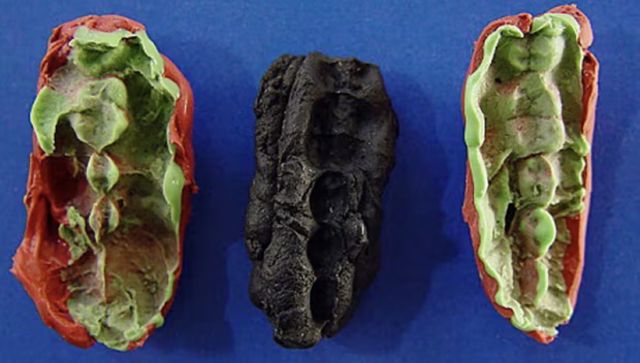Researchers have revealed that DNA extracted from a type of “chewing gum” used by teenagers in Sweden around 10,000 years ago is providing new insights into the Stone Age diet and oral health. These ancient chewing gums were made from pieces of birch bark pitch, a tar-like black resin, combined with saliva, and exhibit clear teeth marks. The gums were discovered 30 years ago alongside bones at the Huseby Klev archaeological site, which dates back 9,700 years and is located north of Gothenburg, one of Sweden’s oldest sites for human fossils. The hunter-gatherers most likely chewed the resin “to be used as glue” to assemble tools and weapons, said Anders Gotherstrom, co-author of a study published in the journal Scientific Reports. “This is a most likely hypothesis – they could of course have been chewed just because they liked them or because they thought that they had some medicinal purpose,” he told AFP. The gum was typically chewed by both male and female adolescents. “There were several chewing gum (samples) and both males and females chewed them. Most of them seem to have been chewed by teenagers,” Gotherstrom said. “There was some kind of age to it.” A previous 2019 study of the wads of gum mapped the genetic profile of the individuals who had chewed it. This time, Gotherstrom and his team of paleontologists at Stockholm University were able to determine, again from the DNA found in the gum, that the teenagers’ Stone Age diet included deer, trout and hazelnuts. Traces of apple, duck and fox were also detected. “If we do a human bone then we’ll get human DNA. We can do teeth and then we’ll get a little bit more. But here we’ll get DNA from what they had been chewing previously,” Gotherstrom said. “You cannot get that in any other way.” In addition, in one piece chewed by a teenage girl researchers found “a number of bacteria indicating a severe case of periodontitis”, a severe gum infection. “She would probably start to lose her teeth shortly after chewing this chewing gum. It must have hurt as well,” said Gotherstrom. “You have the imprint from the teenager’s mouth who chewed it thousands of years ago. If you want to put some kind of a philosophical layer into it, for us it connects artefacts, the DNA and humans,” he said. With inputs from agencies.
Prehistoric ‘chewing gum’ sheds light on stone age teenagers’ diet and disease
FP Staff
• January 24, 2024, 16:25:06 IST
The gums were discovered 30 years ago alongside bones at the Huseby Klev archaeological site, which dates back 9,700 years and is located north of Gothenburg, one of Sweden’s oldest sites for human fossils.
Advertisement
)
End of Article